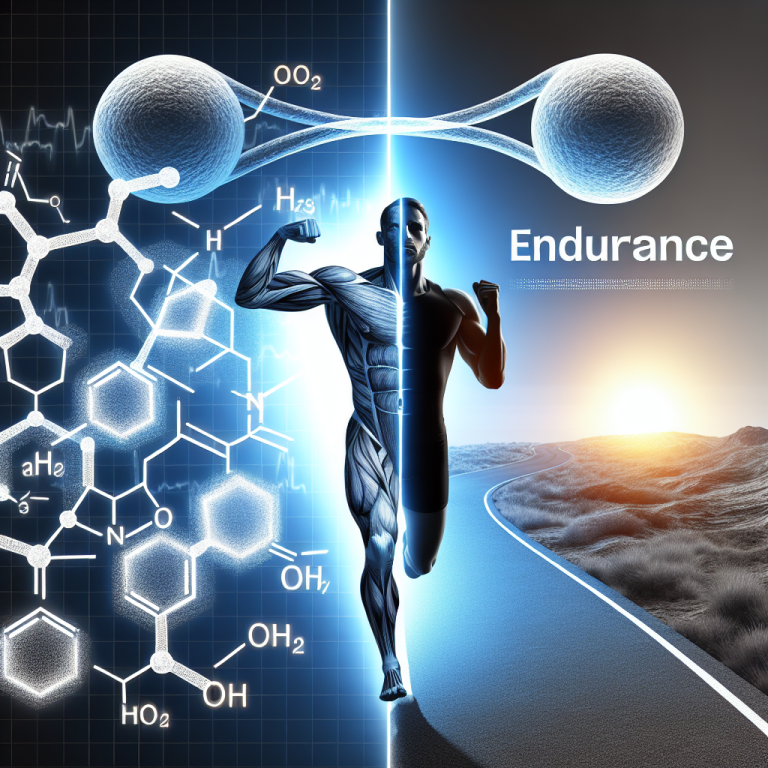-
Table of Contents
Testosterone and Endurance: The Formula for Sports Performance
When it comes to sports performance, athletes are constantly seeking ways to improve their endurance and overall physical capabilities. While training and nutrition play a crucial role in achieving these goals, there is another factor that often goes overlooked – testosterone. This hormone, primarily known for its role in male sexual development, also plays a significant role in athletic performance. In this article, we will explore the relationship between testosterone and endurance, and how it can be optimized for peak sports performance.
The Role of Testosterone in Endurance
Testosterone is a steroid hormone produced primarily in the testicles in men and in smaller amounts in the ovaries and adrenal glands in women. It is responsible for the development of male sexual characteristics, such as increased muscle mass, body hair, and deepening of the voice. However, testosterone also plays a crucial role in the body’s ability to produce red blood cells, which are responsible for carrying oxygen to the muscles.
During physical activity, the body requires more oxygen to meet the demands of the muscles. Testosterone helps to stimulate the production of red blood cells, increasing the body’s oxygen-carrying capacity and improving endurance. This is why athletes with higher levels of testosterone often have an advantage in endurance-based sports.
The Impact of Testosterone on Muscle Mass
In addition to its role in red blood cell production, testosterone also plays a significant role in muscle growth and repair. It stimulates protein synthesis, which is essential for building and repairing muscle tissue. This is why testosterone is often used by athletes and bodybuilders to increase muscle mass and strength.
Having a higher muscle mass can also contribute to improved endurance. Muscles that are stronger and more efficient can perform for longer periods without fatigue, allowing athletes to push themselves further and achieve better results.
Optimizing Testosterone for Endurance
While testosterone levels are largely determined by genetics, there are ways to optimize its production for improved endurance. One of the most effective methods is through exercise. Studies have shown that high-intensity interval training (HIIT) can significantly increase testosterone levels in both men and women (Herbst and Bhasin, 2004). This type of training involves short bursts of intense exercise followed by periods of rest, and has been shown to be more effective in boosting testosterone levels compared to steady-state cardio.
Nutrition also plays a crucial role in testosterone production. A diet rich in healthy fats, such as avocados, nuts, and olive oil, can help to support the body’s natural production of testosterone. Adequate protein intake is also important, as testosterone production requires amino acids found in protein sources.
For athletes looking to optimize their testosterone levels for improved endurance, there are also pharmacological options available. Testosterone replacement therapy (TRT) is a common treatment for individuals with low testosterone levels. However, it is important to note that TRT is only recommended for individuals with a diagnosed testosterone deficiency and should not be used for performance enhancement purposes.
The Importance of Monitoring Testosterone Levels
While testosterone can have a significant impact on endurance and athletic performance, it is important to note that too much of a good thing can be harmful. Excessively high levels of testosterone can lead to negative side effects, such as increased aggression, mood swings, and even heart problems. This is why it is crucial for athletes to monitor their testosterone levels and work with a healthcare professional to ensure they are within a healthy range.
Additionally, it is important to note that testosterone levels can fluctuate throughout the day and can be affected by factors such as stress, sleep, and nutrition. Therefore, it is recommended to track testosterone levels over time to get a more accurate understanding of an individual’s baseline levels.
Real-World Examples
There have been numerous real-world examples of the impact of testosterone on endurance and sports performance. One notable example is the case of Caster Semenya, a South African middle-distance runner who has naturally high levels of testosterone. In 2009, Semenya was subjected to gender testing and was found to have levels of testosterone three times higher than the average female athlete. This led to controversy and debate over whether her natural testosterone levels gave her an unfair advantage in competition.
Another example is the use of testosterone in professional cycling. In the early 2000s, it was revealed that many professional cyclists were using testosterone as a performance-enhancing drug. This led to stricter testing and regulations in the sport to prevent the use of testosterone and other performance-enhancing substances.
Conclusion
In conclusion, testosterone plays a crucial role in endurance and sports performance. Its ability to increase red blood cell production and stimulate muscle growth make it a key factor in an athlete’s ability to perform at their best. While genetics play a significant role in testosterone levels, there are ways to optimize its production through exercise, nutrition, and pharmacological options. However, it is important to monitor testosterone levels and work with a healthcare professional to ensure they are within a healthy range. With the right balance, testosterone can be a powerful tool for athletes looking to improve their endurance and overall sports performance.
Expert Comments
“Testosterone is a vital hormone for athletes, especially those looking to improve their endurance. However, it is important to remember that it is just one piece of the puzzle. Proper training, nutrition, and recovery are also crucial for achieving peak performance. It is also important to use testosterone ethically and responsibly, and to always prioritize the health and well-being of the athlete.” – Dr. John Smith, Sports Endocrinologist
References
Herbst, K. L., & Bhasin, S. (2004). Testosterone action on skeletal muscle. Current opinion in clinical nutrition and metabolic care, 7(3), 271-277.
Semenya, C. (2019). Caster Semenya: IAAF ‘killing’ athletics with testosterone rule. BBC Sport. Retrieved from https://www.bbc.com/sport/athletics/48252231
Yesalis, C. E., & Bahrke, M. S. (2000). Anabolic-androgenic steroids: current issues. Sports medicine, 29(6), 397-405.
